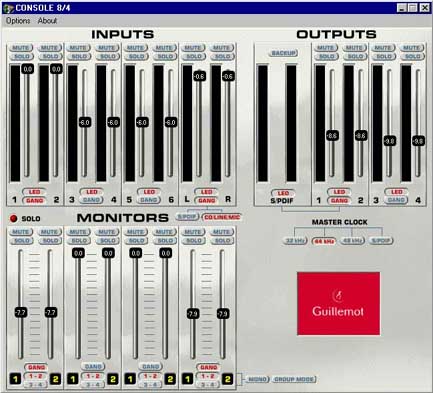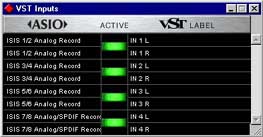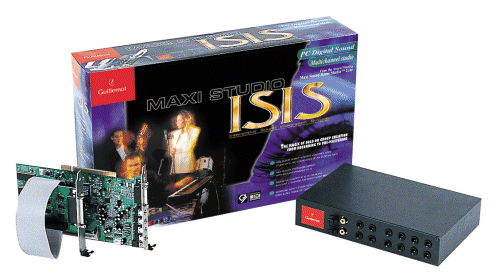All about the ISIS

As far as very recently, Soundcards allowing multitrack audio recording were reserved to professionals, recording studios or to very riches amateur musicians because they were very expansive. Morever, this hardware was made only for a studio using. In order to use your computer for something else than studio, you needed to get another multimedia soundcard. So many computer-assisted music amateurs craziest dream was to buy the cheapest card able to record multitrack audio and to endure multimedia processing. As far as very recently, this was nothing else but a dream.
This is probably to make this incredible dream a reality that Guillemot built the Maxi Studio ISIS. It?s specifications speak for themselves : 8 in, 4 out Jack 1/4 inches, in and out S/Pdif RCA and optical, midi in and out, a 4 Mo. midi sound bank extensible to 36 Mo, DirectX, ASIO and DOS compatibility, Full Duplex. However, after the first test, does this card hold all it?s promises ?
Stong oints
The strongest point of this card is the external rack. By putting analogics in and outs and their respective converters (A/D and D/A) in the external rack, Guillemot ensures us to make sound recordings without any pollution from the CPU as it generally was with a standard soundcard. Moreover, this rack simplifies the access to the different important sockets (analogic, Digital, MIDI). No more tumbling to plug your cable at the back of your computer.


Another good decision from Guillemot was to choose 1/4 inches plugs for the audio on this rack. Some would have preferred XLR plugs but considering the market this card has been made for, it was fully sufficient for good quality recordings. Moreover, A/D and D/A converters seem to be first-rate, ( 20 Bits according to Guillemot ): trusting my own experience, there is very little noise. Meanwhile, this noise can be perceptible if the source is weak, just like a mike directly plugged in the rack.

The 8/4 console which allows you to control the in and out level is of an intelligent conception. But the most interesting are the two input level buttons. There is the input for the sound you really record and the monitoring level which is the sound you?ve just recorded. This really simplifies the job. Morever, you can select the sample frequency.
The midi sounds (instruments) given with the card are pretty good and use almost completely the 4 Mo. The very interesting point is that you can add RAM (as far as 36 Mo. with the SIMM Memory module) so that the card is used just like a real expander. More than 200 Mo. of sounds are given with the installation CD. Edition tools are not very user-friendly but can manage the job correctly.
The softwares given with the card are ok and able to manage their work. For the DtD recording beginners, those softwares are quite complete but can?t replace professional solutions that are more functional. For example, the soft Logic Audio Pro makes a correct work but doesn?t give any regrets if you?ve also bought Cubase VST.

Talking about cubase, the ISIS works efficiently with and the synchronicity is very strong, thought there is no real ASIO. In Cubase VST, the Isis is easy to configure and the multitrack recording works very well. The access to the midi sounds is as easy as with any other ordinary multimedia soundcard.
It is true that the CPU have to be rebooted to switch the mode from 8/4 the multimedia standard and vice versa. Never mind anyway, the multimedia mode is totally unuseful. The only profit of this mode is the capacity in adjusting effects such as reverb, chorus, surround on the wave files and in the lines, mike and CD inputs. This is then completely unseful in a home-studio since effects are generally provided by multitrack audio-recording software plug-ins? or may be calculated by the sound editors. More, the 8/4 mode can also be used like a standard DirectX compatible soundcard under Windows. I tried directX games like Tomb Raider 2, Diabolo and Tonic Trouble; they work excellently with the 8/4 mode (my loud speakers are connected on the 1st and 2nd output of the external rack). Excepted if you play with DOS games, you can keep the 8/4 without any problem. More, this card uses the PCI BUS control and then, uses very few processor interventions. With a soft just as Cubase VST, this allows then the processor to concentrate it?s work on the real-time audio treatment.
More, this card uses the PCI BUS control and then, uses very few processor interventions. With a soft just as Cubase VST, this allows then the processor to concentrate it?s work on the real-time audio treatment.
Last advantage of this card : the price. For a solution under 500$ Cdn, it?s hard to find a competitor giving so much.
Weak points
The installation of the ISIS is not necessarily without problems. If you?re lucky, everything is gonna be all right. But you may expect some hardware troubles if, in the BIOS you did not set your OS as ?NON plug & play?. If you have an AMD K6-2, with a viaTech MPV3 chipset, just like I have, your troubles are not over yet. Thought the card boots each time the CPU does, it won?t probably be detected when booting from windows.
Installing the memory modules brings it?s kit of troubles. Some memory modules are just half detected. I saw a 32Mo.EDO detected like a 16 Mo. and a standard 32 Mo. non-parity detected as a 4 Mo. I hardly recommend SIMM EDO modules with memory chips on both sides. You?ll avoid bad surprises.
But the weakest point of this card is that it needs an amplified source. It can?t receive a direct microphone because this one won?t probably be powerful enough. So I recommand to work with an external input rack in order to amplifie the different sources. It?s allways possible, with the 8/4 console, to increase the input level of 6 deciBels, but this function may generate bad surprises. Actually, this colours badly the sound. Then, the recorded sound and the one to record may be quite different. This difference become more perceptible if one?s record midi instrument to audio.
Conclusion

We?ve got to yield to the facts : the maxi Studio ISIS from Guillemot is a good product. This card does not pretend to be a professional solution just like the DSP Factory from Yamaha or any multitrack 24bits/96kHz. It?s clearly designed for those who want a home-studio based upon the computer and who desire an adaptable card for the multimedia. For the amateur musician who wants to use it?s computer to produce himself (from the recording to production of its CD), this card is a very good choice and a sure thing, specially if we compare it with it?s competitors due to the Quality/price ratio. For example it?s once and a half more expensive than the Sound Blaster Live complete version Card, but it?s row of softwares is of an highest quality and it?s eight inputs are enough to justifie a bigger price. If we compare now with 16Bits/44.1 or 48kHz multitrack solutions which are generally twice or three times more expensive, the ISIS got no cause to be envious of the other. On the contrary, for a professional studio, a 24bits/96kHz multitrack card, combined with Cubase VST/24 would be a more logical choice, especially with the Audio DVD invention.





